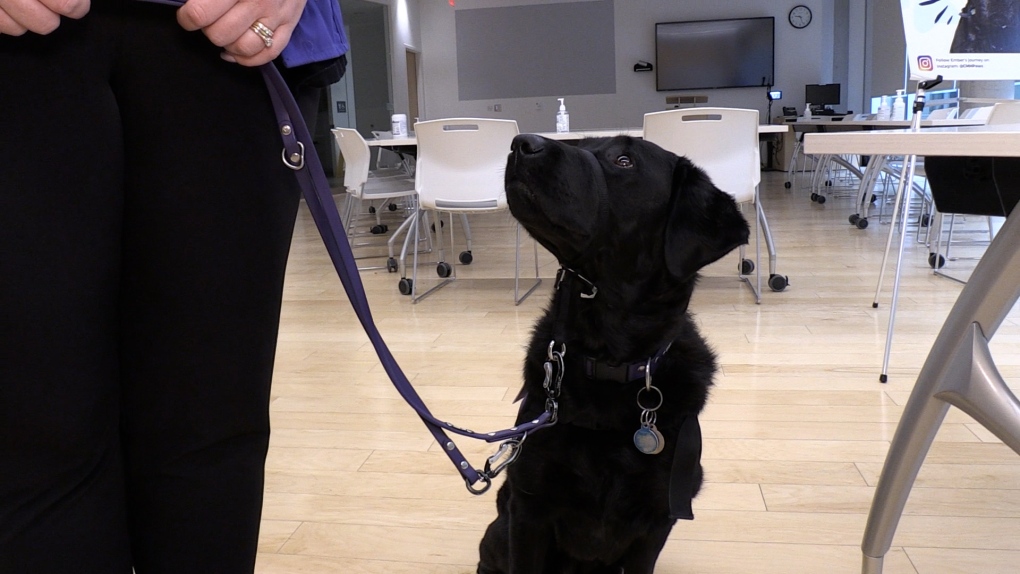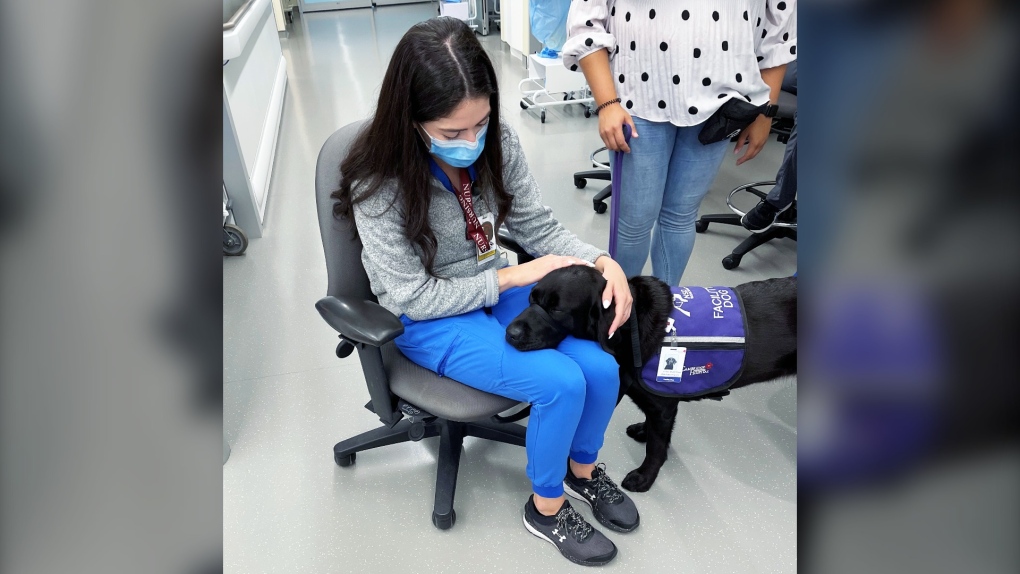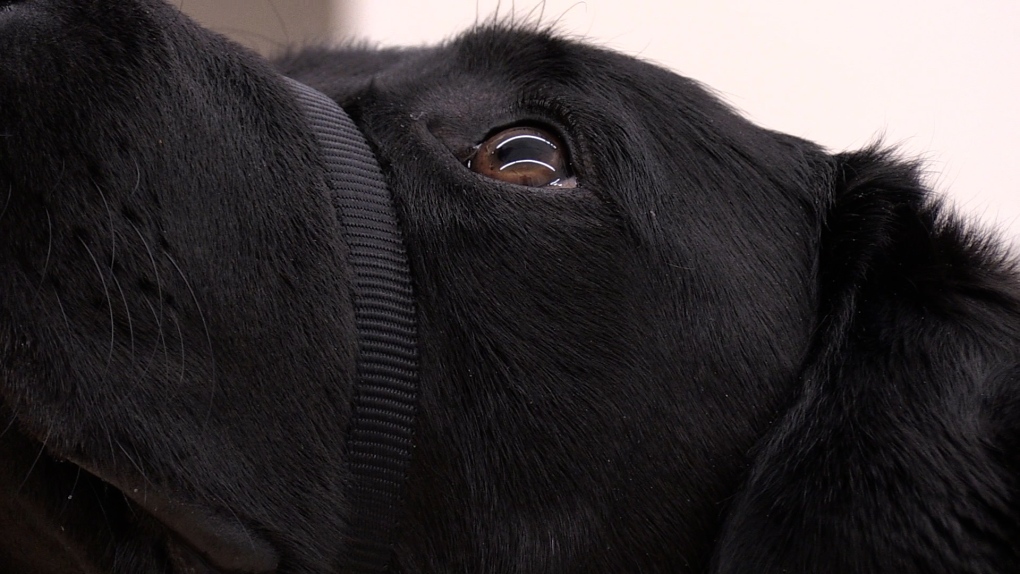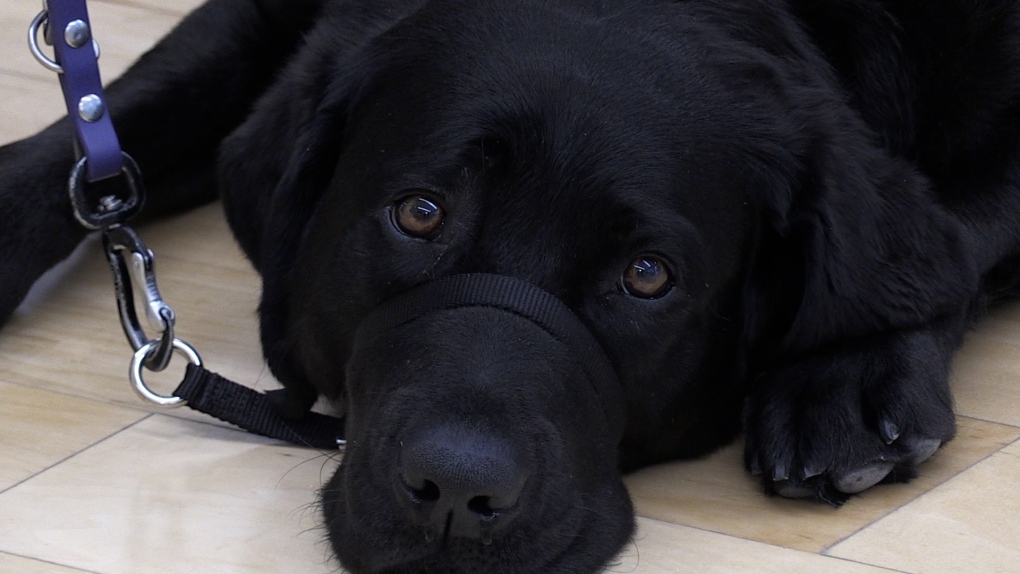Researchers to study impact of facility dog at Cambridge Memorial Hospital
A dog at Cambridge Memorial Hospital is set to be one of the main subjects of a University of Guelph study.
National Service Dogs (NSD)-certified facility dog Ember has been working at the hospital since May 2022. The Labrador retriever helps provide mental health support for staff, physicians, midwives, and volunteers.
"Her entire role is to be part of the mental health team here at the hospital, supporting staff,” Danielle Forbes, executive director and co-founder of National Service Dogs said.
"Certain people get excited to see her," Jenna Bilenduke, wellness and wellbeing specialist at Cambridge Memorial Hospital said. "They see her coming. They'll turn their chair around and they'll kind of put their hands on her lap for her to jump over their lap."
Cambridge Memorial said it’s the first hospital in Canada to have a dedicated facility dog provided by National Service Dogs. Ember is not a therapy dog, and rarely interacts with the public. The hospital does have two therapy dogs that can work with patients, but Ember is meant for the staff.
Now, the University of Guelph is planning to research the impact Ember is having.
"[We’re] particularly interested to see how Ember can support staff. More importantly, we want to make sure that staff are well and also that we retain staff," said Basem Gohar, assistant professor in the Department of Population Medicine at the Ontario Veterinary College at the University of Guelph.
 National Service Dogs-certified facility dog Ember at Cambridge Memorial Hospital on April 4, 2024. (Colton Wiens/CTV Kitchener)
National Service Dogs-certified facility dog Ember at Cambridge Memorial Hospital on April 4, 2024. (Colton Wiens/CTV Kitchener)
Gohar said with the stress healthcare workers face on the job and staffing shortages causing burnout, he wants to see if there is a way to help.
"Finding any novel ideas to help retain staff and support their mental wellbeing is crucial," Gohar said.
Research is set to begin on May 1. A graduate student will document Embers interactions with staff, and survey workers, to see if there is a correlation between the visits and staff mental health.
"Their perceived work support, organizational commitment and their well-being," Gohar said.
Gohar says the initial research could take weeks to months, just until they have enough information come to a conclusion and as long as Ember is ready to work.
 Ember knows commands like "visit," which instructs her to rest her head on your lap. (Colton Wiens/CTV Kitchener)
Ember knows commands like "visit," which instructs her to rest her head on your lap. (Colton Wiens/CTV Kitchener)
Ember will be turning four years old this year and is expected to spend at least another five years working at the hospital.
"Each of our working facility dogs, we aim to retire them around nine or ten years of age. So she's actually got probably five or six more years of good work left in her,” Forbes said.
Ember works eight hour shifts and visits different staff throughout the day. She gets numerous breaks to destress and play. Different staff have trained as handlers and take turns with Ember.
Jenna Bilenduke, a wellness and wellbeing specialist at CMH, has been one of her handlers since Ember first came to the hospital and has seen how the staff and the dog have bonded.
"When she started, [she was] a bit more gentle in her visits, was a bit more cautious, getting to understand her environment, the people. I also have noticed her pick up on people's reception to her and over time that bond has built," Bilenduke said.
 "She just looks at you with her Ember eyes and she just takes everything away," says Nina Grealy, an administrative assistant for the chief of staff and medical affairs at CMH. (Colton Wiens/CTV Kitchener)
"She just looks at you with her Ember eyes and she just takes everything away," says Nina Grealy, an administrative assistant for the chief of staff and medical affairs at CMH. (Colton Wiens/CTV Kitchener)
National Service Dogs taught Ember how to be close to people, including sitting on laps and giving hugs. She knows a few cues to respond to when working with staff. The word “lap” instructs her to climb across someone’s lap. “Close” leads to Ember going between your legs for a hug. If you say “visit” she'll come and rest her head on your lap and “chin” instructs Ember to rest her head on an outstretched hand.
Bilenduke said bringing Ember around to other staff also gives her a chance to meet more colleagues.
"They ask questions about Ember, we connect about their pets or other things that may bring them joy at home. Yeah, it really has opened that door for me as well," Bilenduke said.
 Ember is set to turn four years old this year and is expected to spent at least another five years working at the hospital. (Colton Wiens/CTV Kitchener)
Ember is set to turn four years old this year and is expected to spent at least another five years working at the hospital. (Colton Wiens/CTV Kitchener)
Nina Grealy, an administrative assistant for the chief of staff and medical affairs at CMH, first met Ember in 2022. She then became a handler for Ember in November 2023.
"I have dogs at home. So of course, when anybody is an animal lover and they have to leave their animals at home for any period, and you come to the hospital, if you're in a stressful situation or even if you're around stressful situations if you're not directly impacted, you do feel it. Then when Ember comes she makes you feel better," Grealy said.
Grealy said her relationships at work have also grown since becoming a handler, adding Ember has a way of helping her colleagues relax.
"She just looks at you with her Ember eyes and she just takes everything away," Grealy said.
CTVNews.ca Top Stories

BREAKING Baby and grandparents killed in wrong-way crash involving police on Ontario's Highway 401
An infant and the child's grandparents – aged 55 and 60 – were all killed when a vehicle being pursued by police in the wrong direction on Highway 401 in Whitby, Ont. caused a crash involving at least six vehicles, the Special Investigations Unit says. The driver of the suspect vehicle also died.
Judge holds Trump in contempt, fines him US$9,000 and raises threat of jail in hush money trial
Donald Trump was held in contempt of court Tuesday and fined US$9,000 for repeatedly violating a gag order that barred him from making public statements about witnesses, jurors and some others connected to his New York hush money case. If he does it again, the judge warned, he could be jailed.
McGill requests 'police assistance' over pro-Palestinian encampment
McGill University says it has 'requested police assistance' about the pro-Palestinian encampment on its lower field.
New cancer treatment approved, but not everyone thinks it's what's best for patients
A new cancer treatment recently approved in Canada promises to cut treatment time down to just minutes, but experts have differing opinions on whether it's what's best for patients.
Air Canada walks back new seat selection policy change after backlash
Air Canada has paused a new seat selection fee for travellers booked on the lowest fares just days after implementing it.
Province boots mayor and council in small northern Ont. town out of office
An ongoing municipal strike, court battles and revolt by half of council has prompted the province to oust the mayor and council in Black River-Matheson.
This is how many dentists have actually signed up for Canada's new free dental program
A new Canadian dental care program is offering the hope of free care to millions, but while 1.7 million people have signed up for the plan, only about 5,000 dentists have done the same.
Sword-wielding man attacks passersby in London, killing a 13-year-old boy and injuring 4 others
A man wielding a sword attacked members of the public and police officers in a east London suburb early Tuesday, killing a 13-year-old boy and injuring four others, authorities said.
Police searching for 'armed man' in Dartmouth, N.S., residents asked to shelter in place
Residents in the area of Gaston Road in Dartmouth, N.S., are being asked to shelter in place as police search for an armed suspect.




























